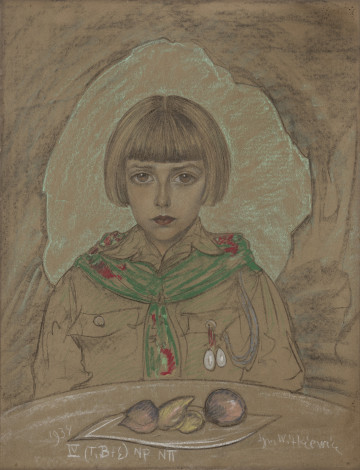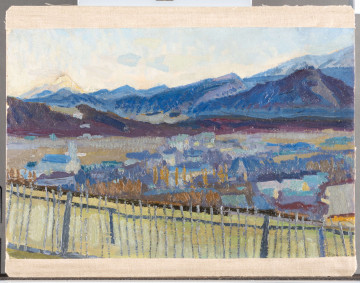
Untitled (Covering)
2022
National Museum in Szczecin
Part of the collection: European classics of modernity
Wacław Wąsowicz studied under Mieczysław Kotarbiński at the Warsaw School of Drawing (1909-1910), under Ignacy Pieńkowski at the local School of Fine Arts (1911-1914), and under Jacek Malczewski at Kraków's Academy of Fine Arts (1914). Having obtained a position as a teacher of drawing at Kazimierz Kulwieć's secondary school, he returned to his hometown and there, with Romuald Kamil Witkowski, Mieczysław Szczuka and Jerzy Zaruba, he founded the Warsaw wing of the Polish Expressionists (from 1919 the Formists). In the Formist period (1918-1922), influenced by the paintings of Paul Cézanne and André Derrain, he began to cubify the imagined space and capture objects with black contours. The linearism of Wąsowicz's works gained importance in the 1920s with his interest in folk woodcuts and village life. The vernacularism of his works at that time resulted from widespread regenerative processes in art theory that had been going on since the turn of the century, as well as efforts to develop a national style. On the wave of this fascination, Ruthenian-Carpathian themes appeared, visible in several oil-painted versions of the painting Huculi w drodze [Hutsuls on the Road] (Pochód Hucułów [The Hutsul Procession], Droga na Huculszczyźnie [Road in the Hutsul Region]), as well as in woodcut works, sometimes underpainted in watercolour (Głowa Hucułki [The Head of the Hucul Woman], Hutsul Himczak i Paraska [Hutsul Himczak and Paraska], Koń z wózkiem [A Horse with a Cart], Chłop z wózkiem [A Peasant with a Cart]). The density of matter, compositional crowding and decorativeness, which is characteristic for painting compositions, culminated in works from 1923-1925. During an exhibition in Garliński's salon (1925), Wąsowicz, praised by critics as a born decorator, showed, among others, unique ceramics inspired by products from Pokucie region. In the following years, the paintings became more and more sketchy and classical-Arkadian, although Hutsul motifs still appeared in Wąsowicz's woodcuts in the following decade, this time in a more austere, deliberately infantilised edition.
Szymon Piotr Kubiak
Author / creator
Dimensions
cały obiekt: height: 70,5 cm, width: 80 cm
Object type
painting
Creation time / dating
Creation / finding place
Identification number
Location / status

2022
National Museum in Szczecin

1934
National Museum in Szczecin

National Museum in Lublin
DISCOVER this TOPIC
National Museum in Szczecin
DISCOVER this PATH
Educational path